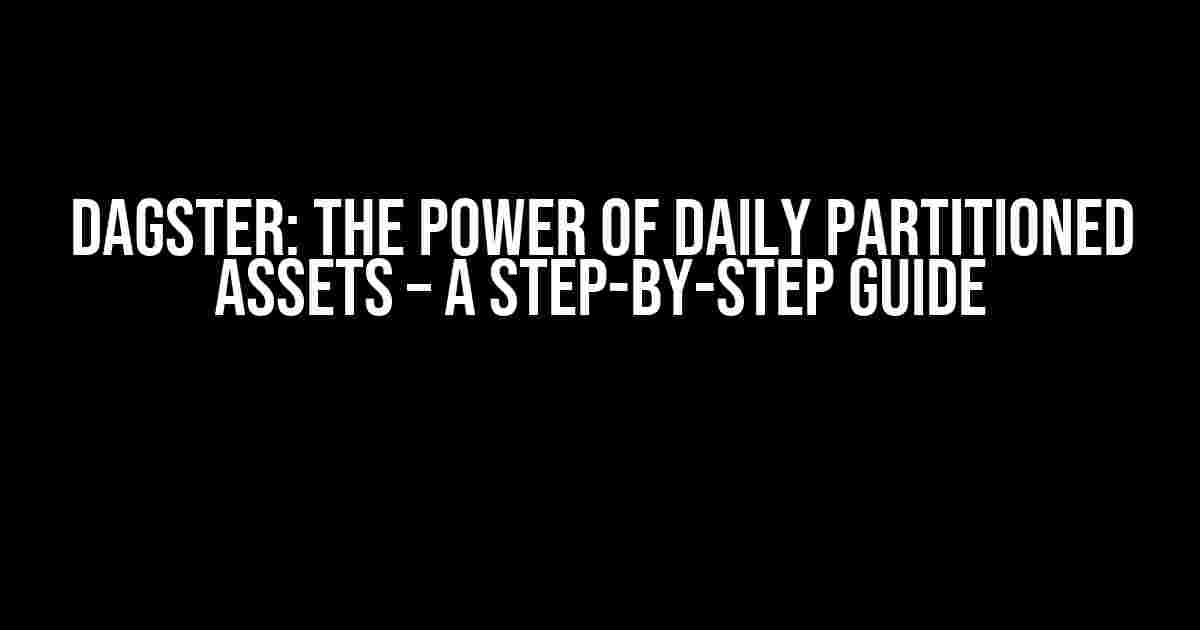Are you tired of dealing with cumbersome workflows and inefficient data processing? Look no further! Dagster, a cutting-edge data infrastructure tool, is here to revolutionize the way you handle your daily partitioned assets. In this comprehensive guide, we’ll take you on a journey to explore the concept of Dagster having a daily partitioned asset depend on the previous partition.
What is Dagster?
Dagster is a modern data orchestration tool designed to simplify complex data workflows. It allows you to define, schedule, and execute data pipelines with ease. With Dagster, you can create reusable, modular, and scalable data assets that can be easily composed together to form powerful workflows.
What is a Daily Partitioned Asset?
In Dagster, a daily partitioned asset is a type of asset that is executed on a daily basis, typically to process and transform data. These assets are designed to handle large datasets and are ideal for tasks such as data ingestion, processing, and storage.
Why Depend on the Previous Partition?
By having a daily partitioned asset depend on the previous partition, you can create a seamless data processing workflow that ensures data consistency and accuracy. This approach allows you to:
- Process data in a continuous and incremental manner
- Reduce data duplication and inconsistencies
- Improve data freshness and accuracy
- Simplify data backup and recovery processes
Configuring Dagster for Daily Partitioned Assets
To get started with Dagster and daily partitioned assets, you’ll need to install and configure Dagster on your machine. Follow these steps:
pip install dagster(install Dagster using pip)- Create a new Dagster project using
dagster new my_project - Define your daily partitioned asset using the
@daily_partitioned_assetdecorator
from dagster import daily_partitioned_asset, daily_partitionchedule
@daily_partitioned_asset(
name="my_daily_asset",
partitions_def=DailyPartitionsDefinition(
start_date=datetime.date(2022, 1, 1),
end_date=datetime.date(2025, 12, 31),
interval=1,
),
)
def my_daily_asset(context):
# Define your asset logic here
pass
Scheduling the Daily Partitioned Asset
To schedule the daily partitioned asset, you’ll need to create a schedule using the @daily_schedule decorator. This schedule will trigger the asset execution at a specified time each day.
@daily_schedule(
name="my_daily_schedule",
cron_schedule="0 0 * * *", # Execute at 12:00 AM every day
pipeline_name="my_pipeline",
)
def my_daily_schedule(context):
# Define your schedule logic here
pass
Dependent Assets and Partitioning
To create a dependent asset that relies on the previous partition, you’ll need to define a new asset that uses the previous partition as an input.
@asset(
name="my_dependent_asset",
ins={"my_daily_asset": AssetIn(
asset_key=AssetKey("my_daily_asset"),
partition_key=PartitionKey("previous_partition"),
)},
)
def my_dependent_asset(context, my_daily_asset):
# Define your dependent asset logic here
pass
Understanding Partition Keys
A partition key is a unique identifier that represents a specific partition of data. In Dagster, partition keys are used to define the input and output partitions of an asset.
| Partition Key | Description |
|---|---|
| PartitionKey(“previous_partition”) | Represents the previous partition of data |
| PartitionKey(“current_partition”) | Represents the current partition of data |
Executing the Daily Partitioned Asset
To execute the daily partitioned asset, simply run the following command:
dagster run my_pipeline
This will trigger the execution of the daily partitioned asset, which will process the data and create a new partition. The dependent asset will then be executed, using the previous partition as an input.
Conclusion
In this comprehensive guide, we’ve explored the concept of Dagster having a daily partitioned asset depend on the previous partition. By following the steps outlined above, you can create efficient and scalable data workflows that ensure data consistency and accuracy. With Dagster, you can simplify complex data processing tasks and unlock the full potential of your data.
Remember, the key to success lies in understanding the concept of partitioning and dependencies in Dagster. By mastering these concepts, you’ll be able to create powerful data workflows that drive business value and insights.
Happy Dagster-ing!
Here are 5 Questions and Answers about “Dagster having a daily partitioned asset depend on the previous partition”:
Frequently Asked Question
Solve the mystery of Dagster’s daily partitioned asset!
What’s the big deal about Dagster’s daily partitioned asset?
Dagster’s daily partitioned asset is a game-changer because it allows you to process large datasets in a scalable and efficient way. By breaking down the data into smaller chunks, you can focus on specific parts of the data without having to reprocess the entire dataset.
How does Dagster’s daily partitioned asset depend on the previous partition?
The beauty of Dagster’s daily partitioned asset is that each partition is built on top of the previous one. This means that the processing of each partition takes into account the results of the previous partition, allowing for a more accurate and up-to-date processing of the data.
What are the benefits of having a daily partitioned asset in Dagster?
The benefits are numerous! With daily partitioned assets, you can reprocess only the latest data, reducing the computational overhead and making the processing more efficient. You can also easily add new data to the pipeline, and the processing will automatically take into account the new data.
Can I use Dagster’s daily partitioned asset for real-time data processing?
Yes! Dagster’s daily partitioned asset is perfect for real-time data processing. Since each partition is built on top of the previous one, you can easily process new data as it arrives, ensuring that your pipeline is always up-to-date and reflective of the latest data.
How do I get started with Dagster’s daily partitioned asset?
Getting started is easy! Simply create a new Dagster pipeline, define your daily partitioned asset, and configure the dependencies between the partitions. Dagster will take care of the rest, ensuring that your pipeline is running smoothly and efficiently.

